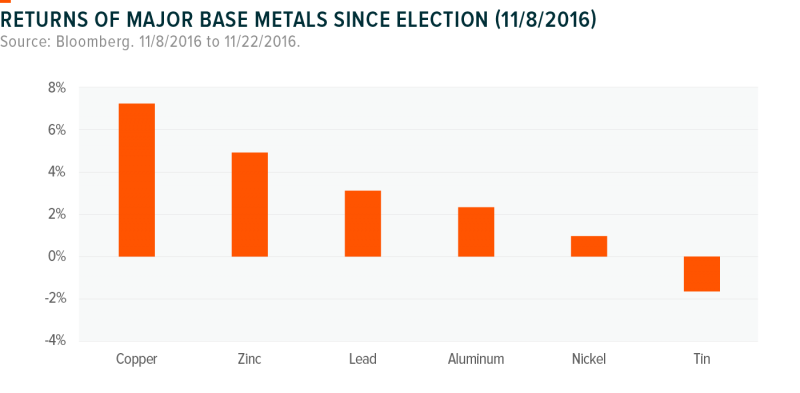Beyond the US Election: Investing in Infrastructure via Copper
That the US’s infrastructure is in dire need of repair and fixing it is perhaps the most prominent policy issue that both Clinton and Trump agreed upon. Many believe that repaving roads, expanding highways, improving railways and ports, and building out digital superhighways should make conducting business easier and faster and, in turn, stimulate the country’s GDP growth. Since the election, the markets have rewarded investments that are expected to benefit from Trump’s proposal to spend $1 trillion on rebuilding and expanding the US’s aging infrastructure.
How Are the Base Metals Performing Since the Election?
Base metals have been one such beneficiary, with five of the six major base metals registering positive returns, despite rising 10-year treasury yields and a strengthening dollar, which tend to have a negative impact on commodities. Some may be surprised to see that copper has been the best performer among the base metals, registering a 7.25% increase in spot prices since November 8th, while touching on 16-month highs and near records of open interest in copper futures.1

Why Has Copper Outperformed the Other Major Base Metals Since the Election?
Copper is most widely used in electrical wiring given its properties as an excellent electrical conductor. Therefore, demand for the metal is most closely linked with growth in heavy machinery, consumer durables, electrical grids, and telecommunications. It is not known exactly what government support for new infrastructure will look like, but copper indirectly touches many of these improvements:
- Erecting new bridges, highways, and ports requires goliath machines to do the job.
- Once completed, these new projects are likely to attract investments in new cars, trucks, trains, cargo ships, and airplanes, all of which use copper extensively.
- Should new infrastructure policies also focus on improving digital communications, copper is likely to see significant increases due to its prevalent use in wiring.
Conclusion
While the markets await more specific plans on what an infrastructure plan will look like – specifically, how much money and how it will be spent – copper remains one material that stands to potentially benefit from greater infrastructure investment, however those policies ultimately materialize.
 Global X Research Team
Global X Research Team